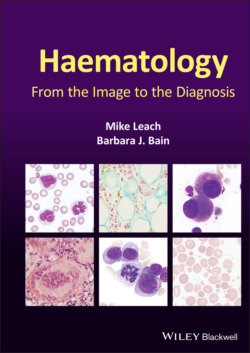Читать книгу Haematology - Barbara J. Bain, Irene Roberts - Страница 16
Оглавление7 Visceral leishmaniasis
A 5‐year‐old boy was referred for investigation of anorexia, abdominal bloating and intermittent fever. On examination he appeared pale and underweight and had palpable splenomegaly. His full blood count showed Hb 100 g/l, WBC 4 × 109/l, neutrophils 2 × 109/l and platelets 247 × 109/l. The blood film showed no specific features. He had a polyclonal increase in immunoglobulins, low serum albumin at 26 g/l and a direct Coombs test that was positive for IgG. CT imaging confirmed splenomegaly but no lymphadenopathy was apparent. A lymphoma was suspected, but in the absence of a suitable biopsy target, bone marrow aspiration and trephine biopsy were performed.
The aspirate was particulate with cellular trails. There was no lymphomatous infiltrate. There were, however, increased numbers of macrophages containing Leishmania promastigotes (left and centre images ×100 objective). Note that the macrophage cytoplasm was disrupted in some cells with the parasites appearing free in the film (centre images). Note that each parasite has a nucleus and a smaller rod‐shaped kinetoplast. Microscopy alone is sufficient to make a diagnosis but serology and molecular studies can be used for confirmation and determining species, respectively. The bone marrow trephine biopsy sections showed maximal cellularity with large numbers of macrophages harbouring parasites being visible (right images ×50). On further questioning regarding the travel history, it was learned that the family had visited Malta on a 2‐week holiday some months previously. The patient was treated with intravenous liposomal amphotericin and made a full recovery.
The term leishmaniasis encompasses multiple clinical syndromes resulting from Phlebotomus sand fly transmission of a variety of Leishmania species; cutaneous, mucocutaneous and visceral forms (the case described above) of the disease result, sometimes many months or years after primary infection. It is present in the tropics, subtropics and southern Europe including the Mediterranean area. It is endemic in dogs in Malta with the implicated organism being Leishmania infantum. Visceral leishmaniasis is a serious infection which should never be overlooked and bone marrow biopsy material should be carefully scrutinised whenever this diagnosis is possible. In this case, the marrow biopsy was taken looking for involvement by lymphoma and the condition was encountered almost by accident. This was also the case for another patient who presented with a perianal ulcer. The biopsy showed granulomatous inflammation and a diagnosis of Crohn’s disease was assumed. He was commenced on azathioprine therapy but developed progressive pancytopenia. A bone marrow aspirate and trephine biopsy were taken, assuming the cause to be drug toxicity but Leishmania parasites were seen and accurately identified in the aspirate films. Review of the skin biopsy showed the granulomatous skin ulcer to be due to cutaneous Leishmania infection.
In tropical and subtropical countries where the infection is endemic, a rapid field hospital method of making a diagnosis is microscopy of a splenic aspirate, taken under local anaesthetic. The images below (×100) are of an MGG‐stained splenic aspirate showing visceral leishmaniasis.
MCQ
1 Leishmaniasis involving the bone marrow:Can be complicated by a haemophagocytic syndromeCan cause granuloma formationCan lead to significant dyserythropoiesisIs easily detected with Grocott’s methenamine silver stainIs often associated with increased plasma cellsFor answers and discussion, see page 206.
